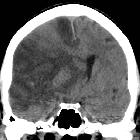transtentorial herniation



Transtentorial herniation is a type of cerebral herniation broadly divided into two major types based on the direction of herniation: downwards due to supratentorial mass effect and upward due to infratentorial mass effect.
Downward transtentorial herniation
Downward herniation occurs when there is mass effect upon or from within the cerebral hemispheres. The pattern of herniation can be divided into lateral and central herniation.
Lateral herniation
Lateral herniation occurs due to unilateral or asymmetric mass effect. The medial parts of the temporal lobe are pushed into the ambient cistern and up against the brainstem. This can be further divided according to whether the herniation is predominantly anterior (uncal herniation), which is most common, or posterior (posterior parahippocampal gyrus and anterior part of the lingual gyrus ) . Anterior and posterior herniation can occur separately or together .
Central herniation
Central herniation occurs when there is symmetric or severe mass effect resulting in downward displacement of the thalami and midbrain.
Upward transtentorial herniation
Ascending transtentorial herniation occurs due to mass effect within the posterior fossa.
Siehe auch:
- uncal herniation
- Kleinhirninfarkt
- ascending transtentorial herniation
- central herniation
- subfalzine Herniation
- zerebraler Mittellinienshift
- Hirnherniation
und weiter:

 Assoziationen und Differentialdiagnosen zu transtentorielle Herniation:
Assoziationen und Differentialdiagnosen zu transtentorielle Herniation:



